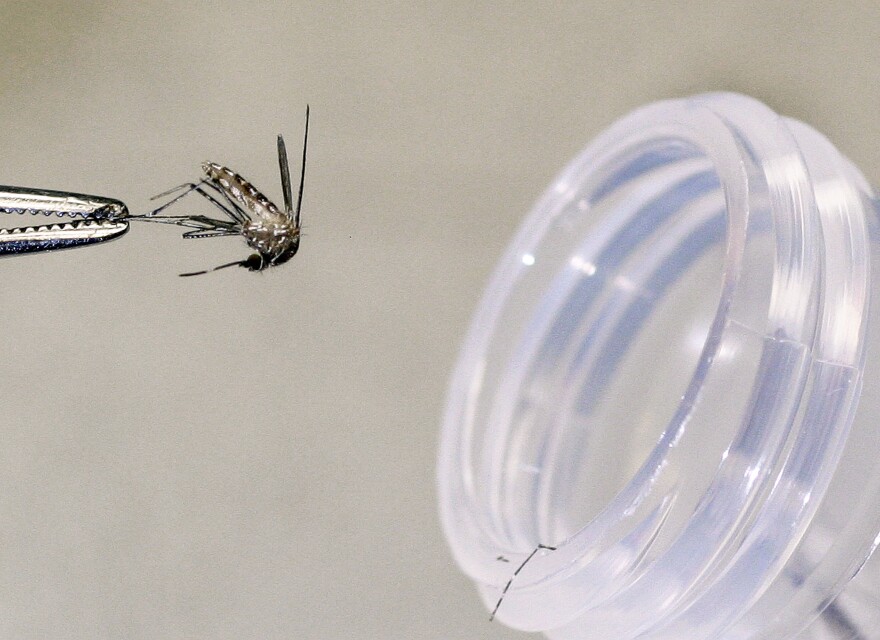Truth matters. Community matters. Your support makes both possible. LAist is one of the few places where news remains independent and free from political and corporate influence. Stand up for truth and for LAist. Make your year-end tax-deductible gift now.
The West Nile Virus Is Back, With The Pesky Mosquitoes Carrying It

It’s officially summer and that means the West Nile virus is back. As a result, Los Angeles County health officials are warning people to protect themselves against the mosquito-borne infection.
“As much as we enjoy the warmer days, so do the mosquitoes. As the days get warmer, we will see more mosquitoes and some of them will be infected with virus,” said Dr. Aiman Halai, vector-borne disease expert with the Department of Public Health.
The West Nile virus first showed up in the U.S. in 1999 and quickly spread. Since then, there have been more than 56,000 reported cases and more than 25,000 have been hospitalized. More than 2,700 people have died. It’s now endemic in all the lower 48 states.
There is no vaccine or treatment to cure the disease, so preventing mosquitoes from getting in your home or breeding nearby is the best defense.
Most people who get infected never know it or recover after just a bad fever, nasty headache and other symptoms. But about 1 out of 150 people who get the virus develop serious complications. West Nile virus can affect the nervous system and can cause encephalitis or swelling of the brain. It can also cause meningitis, which refers to swelling of the fluid and membranes surrounding the brain and spinal cord. Both can cause permanent paralysis and even death.
"About 10% of those people die. People over the age of 50 and with underlying medical problems such as cancer, diabetes, hypertension, being on immunosuppressive medications, those are the conditions that put patients at risk for severe illness from the virus," Halai said.
The bulk of West Nile cases generally occur in August and September in L.A. County, but usually begin in June.
No human cases have been reported yet, but West Nile infected mosquitoes and birds have been found in the San Gabriel Valley, Burbank and throughout the Westside.
How to keep mosquitoes from breeding around your home
- Check and repair holes in screens to keep mosquitoes outdoors.
- Stop mosquitoes from laying eggs in or near standing water. Once a week, empty and scrub, turn over, cover, or throw out items that hold water, such as tires, buckets, planters, toys, pet bowls, flowerpot saucers, rain barrels, or other containers. These are places where mosquitoes lay eggs.
- Empty and wash birdbaths and wading pools weekly.
- Clean and chlorinate swimming pools; drain any water collecting on pool covers.
- Stock garden ponds with fish that eat mosquitos such as mosquitofish, goldfish, or koi. These feed on mosquito eggs and larvae.
- Report stagnant swimming pools or “green pools” to the Public Health Environmental Health Bureau at (888) 700-9995, or to a local vector control agency.
"There was a lot of theorizing initially because of the heavy rains this year. However the weather has been cooler for longer, so our mosquito activity has not been higher than usual,” said Halai. “We are still waiting and watching, and as the days get warmer, we'll start to see more mosquitoes and some of them will be infected. We don’t know yet how severe this season will be."
Health officials are encouraging people to protect themselves. It only takes 7-10 days for an egg to develop into an adult mosquito, so keep emptying any standing water where mosquitoes can breed throughout the summer. People should fix any torn window screens, use insect repellents, wear long sleeves and pants, and try to stay inside at dawn and dusk.
"In 2022 we detected 64 human cases of West Nile virus. In previous years, we've detected over 300 cases. It's very hard to know at the beginning of the season the number of human cases that we would expect because there are so many factors that are involved," Halai said.







